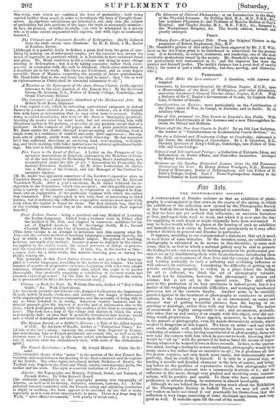irto.
THE PHOTOGRAPHIC SOCIETY.
A correspondent at Dundee informs us that an exhibition of photo- graphy is contemplated in that town in the course of the spring, to which the exhibitors of the collection now opened by the Photographic Society in the Suffolk Street Gallery have promised to contribute. He reminds us that we have not yet noticed that collection ; an omission fortuitous at first, prolonged from week to week, and which it is now past the time for supplying in such detail as might originally have been warranted. It may be better worth while to glance at the bearing of such an exhibition not immediately as it exists in London, but proximately as it may affect remoter districts in general and Dundee in particular.
It appears, according to our correspondent's statement, that art is much in need there of some stimulus. In the broadest sense, an exhibition of photography is calculated to do service in this direction; in some such sense, that is, as that in which a national gallery may be said to promote the feeling for art—not so much by inciting persons to the professional pur- suit of art as by familiarizing them with its productions, introducing these into the daily environment of their lives and the current of their habits, and tending gradually to such a softening and civilizing influence as will subserve its cultivation. Considering the difficulty of getting up an artistic exhibition, properly so called, in a place where the feeling for art is deficient, we think the aid of photography valuable. It must not be forgotten, however, that photography is nature and science, but is not art in the special sense. The skill which goes to the production of its best specimens is indeed great, but it is a matter of the weighing of scientific difficulties, and managing mechanical processes, not of the creative faculty. Another point to be carefully guarded against in the treatment of photography as conducive to artistic culture, is the tendency to pursue it as an amusement, an easier and cheaper way cf getting beautiful pictures than the buying of en- gravings or paintings, rather than with any higher feeling. The notion of amusement is highly antagonistic to art ; and no amateur, probably, who takes that up and carries it on simply with this object, ever did any- thing worth preservation. There appears, moreover, to be a fascination in the pursuit of photography, even for minds distinctively artistic, which renders it dangerous in this regard. We kilow an artist—and one whose own works might well satisfy his cravings for beauty and truth in the rendering of nature—who, having experimented in photography, dares not now take his camera with him when he goes out to work, knowing that it would be "all up" with the picture if he had at hand the means of repro- ducing whatever he wanted in two or three seconds. In fact, to the uncrea- tive mind, having a feeling for nature and beauty, photography would be in many cases a bar rather than an incentive to art ; for it produces all that the person requires, not only much more easily, but immeasurably more perfectly, than he could do it himself. It is only in a general way, as lending a specific and detailed character to the love of nature, and bring- ing before us the qualities of reproductive truth, that photography will introduce the artistic element into a community destitute of it; and its influence in this mode, though very gradual and involving some counter- actions, will be positive and useful. To those who have attained some proficiency in artistic feeling, its assistance is almost invaluable. Although we are behind the time for saying much about the Exhibition of the Photographic Society in Suffolk Street, we may telr such of our readers as have not found it out practically for themselves, that the collection is very large, consisting of some thousand specimens, and very good as well. It remains open till the end of the month.
































 Previous page
Previous page